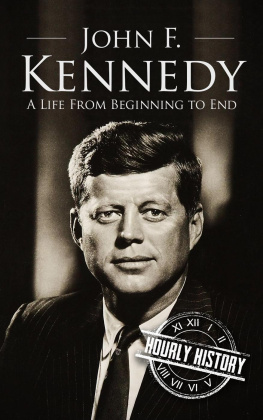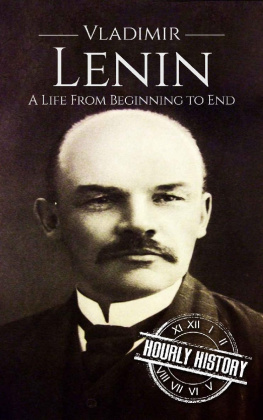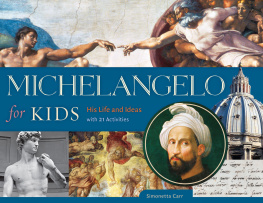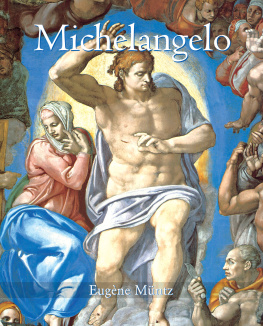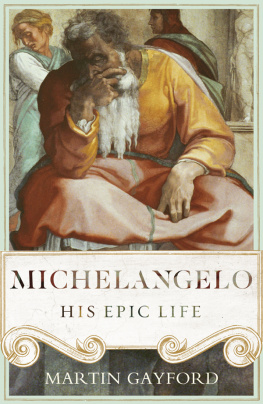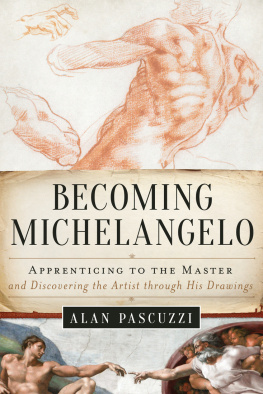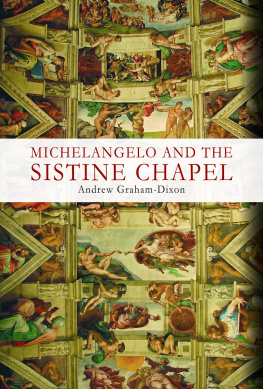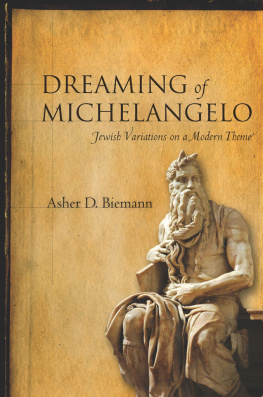MICHELANGELO BUONARROTI
A Life From Beginning to End
Copyright 2018 by Hourly History.
All rights reserved.
Table of Contents
Introduction
The ingenious artist we know as Michelangelo lived during the Renaissance in Northern Italy, and you could say that he was indeed a renaissance manhe was a painter, sculptor, poet, and an engineer all rolled up into one. Even though it has been some 450 years since his passing, his legacy remains one of the strongest on record. If the burgeoning art student of today wishes to learn from the best, he takes his notes directly from Michelangelo.
He lived for his art, and despite the chaos of kings, popes, and the civil government around him, Michelangelo Buonarroti made sure that his works of artistic expression would withstand the scrutiny of time. In this book you will get to learn more about the incredible personality behind the brushstrokes and caresses of clay. Here you will find the full panoramic display and showcasing of a masterful artists life well lived.
Chapter One
Humble Beginnings
It is necessary to keep ones compass in ones eyes and not in the hand, for the hands execute, but the eye judges.
Michelangelo
His full name was Michelangelo di Lodovico Buonarroti Simoni. Like all Italians of that era, his long name was meant to signify his long lineage in the particular region from which he had sprung.
Michelangelo arrived into this world in the early morning hours of March 6, 1475 in the small Italian village of Caprese. He came from a family of bankers, but in all irony, by the time of his birth his own family was nearly bankrupt. The bank had collapsed, and in order to keep the family afloat Michelangelos father, Ludovico di Leonardo Buonarroti Simoni, took a government posting as a local podest, which is an Italian term for a kind of chief administrator. Interestingly enough, Lodovico received this posting completely by chance; in fact, he had been awarded the position after his name had been pulled out of a bag. This random lottery was apparently how local authorities filled the position with eligible citizens. Michelangelos mom was a woman named Francesca di Neri del Miniato di Siena who claimed descent from a countess, Mathilde of Canossa. Before Michelangelo broke out into the art world later in life, this supposed link to the countess was the familys one and only claim to fame.
Shortly after Michelangelos birth, he was sent to the care of a local wet nursea woman whose sole profession is to raise children, her own and those of others. This was a fairly solid tradition at the time, with most children Michelangelos age being reared away from home during the first few years of their life. The surrogate mother assigned to Michelangelo was the wife of a stone mason whose family lived in the town of Settignano near a farm owned by Michelangelos father. Michelangelo would later recall how much this early experience with a family of stone cutters affected his life with the humorous quip, with my wet nurses milk, I sucked in the hammer and chisels I used for my statues. It was supposedly these early roots that put a love for the excavation of stone and ultimately of the making of fine sculptures into young Michelangelo.
Sadly, after these happy times with the stone masons, Michelangelos first taste of tragedy would come at the young and impressionable age of six, when his mother Francesca passed away after a long bout of sickness in 1481. It is said that Francesca was a young mother, perhaps only 18 years old when Michelangelo was born, making her around 24 years of age when she died.
Not long after her passing, in 1485, Ludovico decided to send Michelangelo off to grammar school in order to master the reading and writing of Italian script, andmore importantly for professional circlesto learn Latin. Michelangelos father meanwhile, as his son was sent to Florence, married his second wife, a woman named Lucrezia Ubaldini. Some would later contend that it was for this reason that Michelangelo was pushed out the doorin order to better facilitate the entrance of his stepmother Lucrezia.
At any rate, the ambitious young Michelangelo was more than ready to strike it out on his own. He was only around ten years old when he began his formal education, but he was eager to learn. His education would take a detour however when he met a young artist named Francesco Granacci who would introduce him to a world outside of Italian and Latin grammar. Granacci had already obtained for himself an apprenticeship at the local art studio of the famed Florentine artisans, the two brothers Domenico and Davide Ghirlandaio.
The Ghirlandaio studio was a successful commercial enterprise, and was in high demand at the time, regularly producing a high volume of portraits and frescos for eager buyers. Michelangelo was greatly intrigued by the artists that he encountered at the art studio and began to spend more and more time observing them at work. But when his father received word of Michelangelos new interest, he was distraught, believing his son to be squandering his finite resources on art rather than studying his schoolwork.
According to Michelangelos later recollection, his family was so upset about his growing pastime in art that he even suffered physical violence on occasion because of it. It has been alleged that his father and even some of his uncles beat him up over his love of art. Luckily Michelangelos cash-strapped father began to sing a different tune when he realized just how much of a money maker the Ghirlandaio studio could be. When he received word that Michelangelo would be the recipient of a regular salary of 24 gold florins for the three years of his internship, he finally gave his consent.
Soon Michelangelos talent would prove itself in gold, setting up a lifelong pattern of Michelangelo being the number one bread winning Buonarroti. It was this meagerness at home that gave Michelangelo the determination to succeed and to help support his family.
Chapter Two
Michelangelo Meets the Medicis
It grieves me greatly that I cannot recapture my past, so as to longer be at your service.
Michelangelo
Although 13-year-old Michelangelo was at first more than eager to get his feet wet as an artist, he would later shake his head in disdain when he thought of the commercialized art studio for which he worked. He toiled in a veritable sweatshop of paint, in which he created cheesy mementos for tourists, monotonous frescos for monasteries, and unfulfilling portraits of patrons. It was an assembly line of artwork in which high volume was desired over high quality. Nevertheless, Michelangelo was a dutiful apprentice for the next couple of years that he spent laboring away at the Ghirlandaio studio.
At the age of 15, when his years of indentured service were drawing to a close, Michelangelo finally found his exit from the monotony of the studio. Florence at this time was a bustling city ruled by an even more bustling leader, Lorenzo the Magnificent, or as he was otherwise known, Lorenzo de Medici. Lorenzo was the ruling head in charge of Florence and the family from which he hailed, the Medicis. He was an avid patron of the arts and would later be known to have essentially helped fund the Italian Renaissance. Besides his political career, Lorenzo himself was artistically inclined, and so considered many of the artists he backed as his own peers.
Just as Michelangelos apprenticeship with the Ghirlandaio brothers was coming to an end, he was encouraged to begin to work at Lorenzos personal sculpture garden. This was a special project of Lorenzos in which he encouraged local artists of all stripes to volunteer their time creating sculptures for a sprawling garden near the Medici Palace. This was meant to provide local talent with a chance to demonstrate their ability while also giving the avid art patron Lorenzo a chance to pick out the best artists from the batch.


